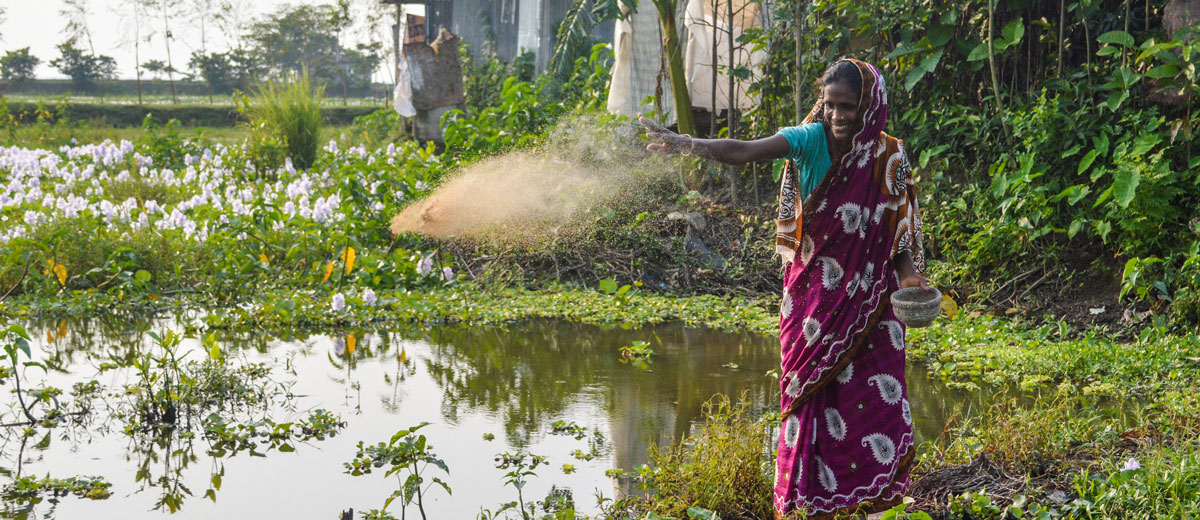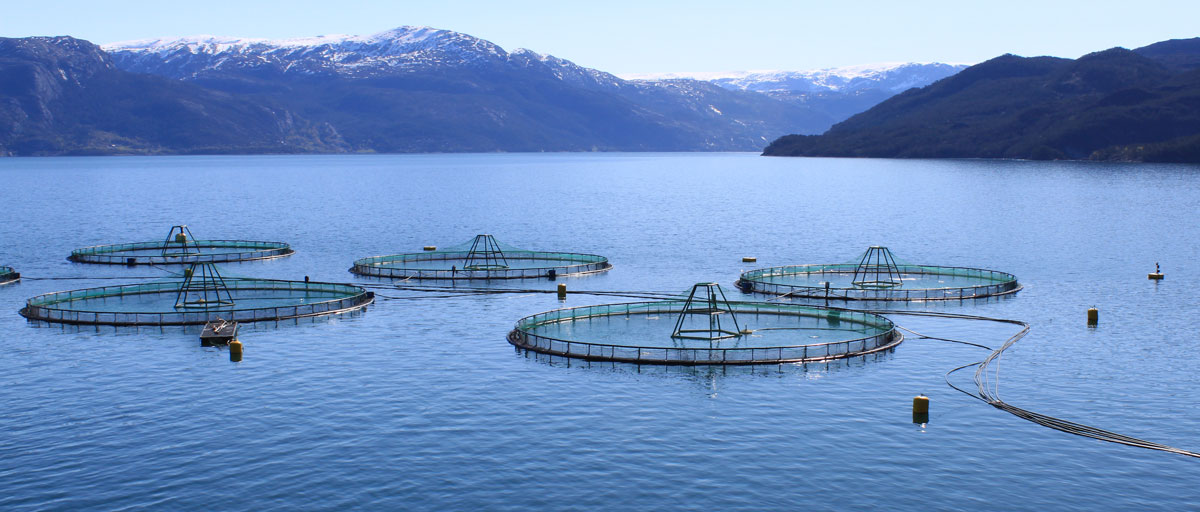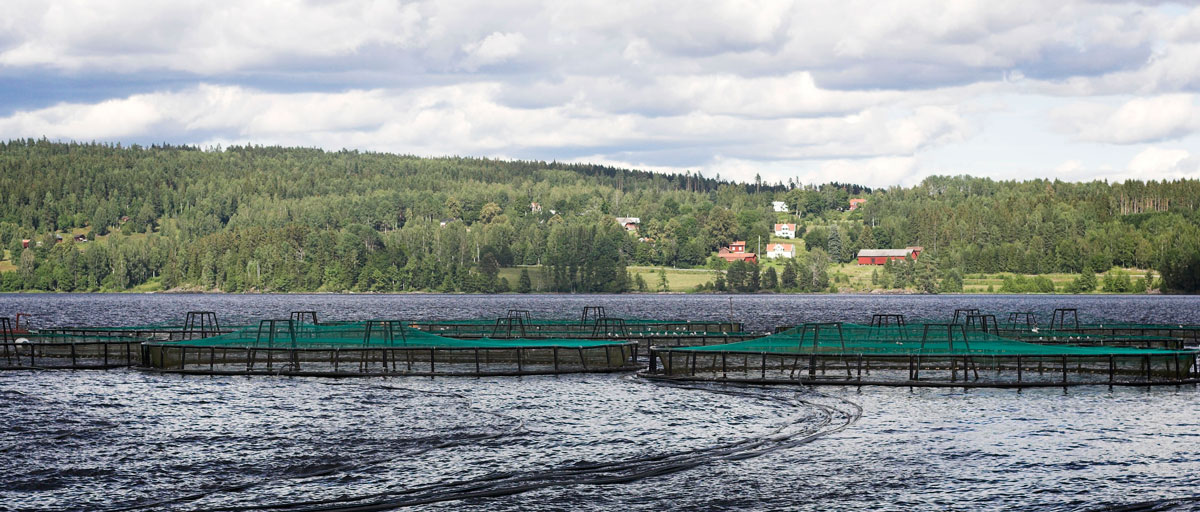
A study recently published in Proceedings of the National Academy of Sciences finds that aquaculture intensification in Bangladesh does not result in escalating environmental consequences across the board. It may even help to reduce certain impacts. Photo: Md. Masudur Rahaman/WorldFish (CC BY-NC-ND 2.0)
Bildtext får vara max två rader text. Hela texten ska högerjusteras om den bara ska innehålla fotobyline! Photo: B. Christensen/Azote
AQUACULTURE
Get it right on fish intensity, get it right for aquaculture
Study from Bangladesh shows that intensification of aquaculture production can reduce some environmental impact, producing more using less
- As demand for food grows, there is an urgent need to produce more using less resources. This concept is known as sustainable intensification
- Aquaculture has risen from relative obscurity to become a major component of the global food system
- Intensification of aquaculture in Bangladesh has not resulted in escalating, but shifting, environmental consequences
In June 2015 centre director Johan Rockström argued that "if we get it right on food, we get it right for both people and planet". He was definitely on to something. Any hope of feeding a growing human population while living within planetary boundaries rests on the ability to transform a currently unsustainable food production system. As demand for food grows, there is an urgent need to limit the environmental consequences of its production by producing more using less. This concept is known as sustainable intensification.
Much focus has been dedicated to how it can help agriculture, the most significant source of environmental degradation, but attention is now being broadened to also include seafood production and aquaculture in particular. Over the past three decades, aquaculture has risen from relative obscurity to become a major component of the global food system. The sector now provides more than half of all fish destined for direct consumption by humans worldwide.
Adoption of a range of simple management practices that also improve farm economic performance has the potential to contribute to sustainable intensification
Patrik Henriksson, lead author
Intensification in Bangladesh
Most assessments of the potential for sustainable intensification rely on only one or two indicators such as greenhouse gas emission or eutrophication. This means that several environmental impacts of the production and distribution of an item remain unaccounted for.
In a study recently published in Proceedings of the National Academy of Sciences centre researcher Patrik Henriksson with colleagues from Bangladesh, the US, and Spain have taken a critical look at the environmental impacts of aquaculture intensification in Bangladesh.
Aquaculture intensification is of particular importance to Bangladesh as it has a higher population density than any other non-city country in the world. There are virtually no possibilities for further agricultural expansion, and arable lands are being lost to urbanization at an alarming rate. Ecosystem degradation and overexploitation of both marine and freshwater ecosystems further threaten future fish production from capture fisheries.
As a consequence, 55% of the fish produced is already being farmed. The intensification of aquaculture is therefore likely to not only continue but to be essential for food production. That also raises the stakes when it comes to the manner in which it is being produced.
Less negative impact
By conducting a Life Cycle Assessment of 2,678 farms, the authors measured how intensified aquaculture production in Bangladesh affected impacts of global warming, acidification, eutrophication, freshwater ecotoxicity, freshwater consumption, and land occupation.
Based on this the researchers found that the intensification only had a negative impact on eutrophication, acidification, and freshwater ecotoxicity, while it was indifferent in terms of global warming and land use, and had a positive effect on freshwater consumption.
"This indicates that the intensification of aquaculture does not result in escalating environmental consequences across the board. It may even help to reduce certain impacts," Henriksson explains.
More fish, less feed
Overall, the researchers believe that more efficient farm management and food provisioning can lead to even further improvements in aquaculture production. That means producing more fish using less feed.
"Adoption of a range of simple management practices that also improve farm economic performance has the potential to contribute to sustainable intensification," Henriksson says.
Improvements in feeding efficiency can be achieved by a variety of means including better feed formulation, use of appropriate feed servings (pellet size and structure), and better on-farm feed management practices such as storage and feeding rates. This would result in some of the largest improvements in the environmental performance of most aquaculture systems.
However, Henriksson and his colleagues warn that with increased intensification a proportionately larger share of the environmental impacts occurs in telecoupled locations outside the farm site and even the other side of the planet. The consequences of different impacts also need be seen at different geographical scales. Global warming acts on a global scale, acidification on a continental scale, and eutrophication, freshwater ecotoxicity, freshwater consumption, and land occupation on a provincial scale.
"Consideration of environmental impacts up to and including the point of consumption therefore remains an important area for future research," they conclude.
Methodology
A total of 2,678 farmers were selected at random from a farm census covering 15 of Bangladesh’s 64 districts, in which the country’s highest concentrations of fish farms are located. Farm data were collected using structured questionnaires, between November 2011 and June 2012. Overall dispersions were calculated using the ‘protocol for horizontal averaging of unit process data’. The protocol quantifies three sources of overall dispersions: inherent uncertainty (inaccuracies in measurements and models), spread (variability resulting from averaging), and unrepresentativeness (mismatch between representativeness and use of data). The final life cycle impact assessment results were later propagated over 1,000 Monte Carlo simulations using CMLCA v5.2.
Link to publication
Henriksson, P.J.G., Belton, B., Murshed-E-Jahan K., Rico A. 2018. Measuring the potential for sustainable intensification of aquaculture in Bangladesh using Life Cycle Assessment. Proc Natl Acad Sci. doi: 10.1073/pnas.1716530115
Patrik Henriksson is a postdoctoral researcher at the Beijer Intistitute of Ecological Economics and Stockholm Resilience Centre. He did his PhD on Asian aquaculture, using Life Cycle Assessment (LCA) to evaluate the environmental consequences of European seafood imports from Asia. His main research interests are related to identifying and promoting more sustainable aquaculture practices








